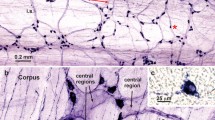Abstract
Nitric oxide (NO)-synthase immunoreactivity has been detected for the first time in mast cells of human normal nasal mucosa, with an antibody specific for neuronal NO-synthase. Intense immunoreactivity was revealed in secretion granules of mast cells but was found in mast cell granules free in the extracellular matrix only in some instances; no reactivity was found in the cytoplasm of this or other cell types. These findings suggest that human nasal mast cells contain a particulate isoform of NO-synthase, which shares epitopes with neuronal NO-synthase and is rapidly removed from granules upon exocytosis.
Similar content being viewed by others
References
Bandaletova T, Brouet I, Bartsch H, Sugimura T, Esumi H, Ohshima H (1993) Immunohistochemical localization of an inducible form of nitric oxide synthase in various organs of rats treated with Propionibacterium acnes and lipopolysaccharide. Acta Pathol Microbiol Immunol Scand 101: 330–336
Bloom GD, Haegermark O (1965) A study on morphological changes and histamine release induced by compound 48/80 in rat peritoneal mast cells. Exp Cell Res 40: 637–654
Bloom GD, Haegermark O (1971) Studies on morphological changes and histamine release induced by bee venom, n-decylamine and hypotonic solutions in rat peritoneal mast cells. Acta Physiol Scand 71: 257–269
Förstermann U, Pollock JS, Schmidt HH, Heller M, Murad F (1990) Calmodulin-dependent endothelium-derived relaxing factor/nitric oxide synthase activity is present in the particulate and cytosolic fractions of bovine aortic endothelial cells. Proc Natl Acad Sci USA 88: 1788–1792
Förstermann U, Schmidt HH, Pollock JS, Sheng H, Mitchell JA, Warner TD, Nakane M, Murad F (1991) Isoforms of nitric oxide synthase. Characterization and purification from different cell types. Biochem Pharmacol 42: 1849–1857
Klatt P, Heinzel B, John M, Kastner M, Böhme E, Mayer B (1992) Ca2+/calmodulin dependent cytochrome C reductase activity of brain nitric oxide synthase. J Biol Chem 267: 11374–11378
Kummer W, Fischer A, Mundel P, Mayer B, Hoba B, Philippin B, Preissler U (1992) Nitric oxide synthase in VIP-containing vasodilator nerve fibres in the guinea pig. Neuroreport 3: 653–655
Mannaioni PF, Masini E, Pistelli A, Salvemini D, Vane JR (1991) Mast cells as a source of superoxide anions and nitric oxide like-factor: relevance to histamine release. Int J Tissue React 6: 271–278
Masini E, Gambassi F, Lupini M, Pistelli A, Mannaioni PF (1992) Correlation between nitric oxide synthesis and histamine release in mast cells from spontaneously hypertensive rats: influence of ageing. Int Arch Allergy Appl Immunol 99: 404–407
Mayer B, John M, Böhme E (1990) Purification of a Ca2+/calmodulin-dependent nitric oxide synthase from porcine cerebellum. Cofactor role of tetrahydrobiopterin. FEBS Lett 277: 215–219
Nathan C (1992) Nitric oxide as a secretory product of mammalian cells. FASEB J 6: 3051–3064
Palmer RM, Ferrige AG, Moncada S (1987) Nitric oxide release accounts for the biological activity of endothelium-derived relaxing factor. Nature 88: 411–415
Palmer RM, Ashton DS, Moncada S (1988) Vascular endothelial cells synthesize nitric oxide from l-arginine. Nature 333: 664–666
Pearse AG (1985) Histochemistry. Theoretical and Applied, 4th edn, vol 1. Churchill Livingstone, Edinburgh
Polak JM, Van Noorden S (1986) Immunocytochemistry. Modern methods and application, 2nd edn. Wright, Bristol
Salvemini D, Masini E, Pistelli A, Mannaioni PF, Vane J (1991) Nitric oxide: a regulatory mediator of mast cell reactivity. Cardiovasc Pharmacol 17 [Suppl 3]: 258–264
Schwartz LB (1988) Preformed mediators of human mast cells and basophils. In: Holgate ST (ed) Mast cells, mediators and disease. Kluver Academic, Dordrecht, pp 129–149
Tharp MD, Seelig LL, Tigelaar RE, Bergstresser PR (1985) Conjugated avidin binds to mast cell granules. J Histochem Cytochem 33: 27–32
Author information
Authors and Affiliations
Rights and permissions
About this article
Cite this article
Bacci, S., Arbi-Riccardi, R., Borghi-Cirri, M.B. et al. Localization of nitric oxide synthase immunoreactivity in mast cells of human nasal mucosa. Histochemistry 102, 89–92 (1994). https://doi.org/10.1007/BF00269011
Accepted:
Issue Date:
DOI: https://doi.org/10.1007/BF00269011




